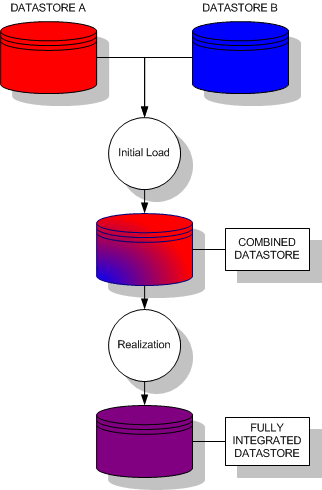Data Integration
Challenge:
One of the top issues facing companies today is cutting costs. How can my company lower ever increasing costs that keep cutting into revenues? One answer that many businesses come up with is consolidation, whether it is a big corporate merger, a departmental restructuring, or even a move from a manual to automated business process. These consolidations can have far reaching implications on the underlying IT infrastructure and its corresponding data stores. How will the personnel records from each company be stored? Are we going to use department A's or department B's database? Can we migrate to one database implementation? These questions of data ownership, data integrity, and data processing which previously may have been clearly defined become less clear.
Solution:
The first step in effectively dealing with data consolidation is a thorough analysis of the data coming from both sides. For the most part, the data may be heterogeneous, unique to each system. However, some parts of each data repository may overlap. Finding these redundancies and dealing with them early on will lessen the possibility of discrepancies surfacing in the future. After working with the data contents, the next task is deciding on a data storage plan. Often more than one vendor's database implementation is involved. Creating a central repository based on one vendor's database can significantly reduce development and maintenance costs. Deciding on which database to use can be daunting. One side declares "We only use MS SQL Server;" while the other side boasts "We only use Oracle." Deciding on one or the other often leads to religious wars between the two camps, but it doesn't have to. A variety of tools and techniques exist to facilitate database integration.

Result:
Media Net Link can answer the questions and provide solutions faced by companies under going consolidation. We recently oversaw the data migration and data integration resulting from the merger of 2 fortune 500 companies. In particular, we dealt with the needs of combining each company's reseller partner information containing partner company names, addresses, personnel listings, and partner relationships. Rather than maintain each individual data store, both were combined into one. This combination had to be done with care in order to preserve the unique attributes of each system. One the other hand, a considerable amount of duplicate information existed on both systems prior to the merger. Using a combination of Oracle SQL and Oracle PL/SQL, Media Net Link applied heuristics to identify duplicate company and employee information across both systems. This process reduced the amount of data, significantly reducing maintenance costs and at the same time ensured the information was reliable and accurate.
For a variety of reasons, your company's data may be located in several physical locations. Eventually there may come a time when this data becomes consolidated, due to company mergers or simply to eliminate the high cost of maintaining multiple data stores. Some of the issues that can arise from this process; modification of existing processes to accommodate new data, duplicate or overlapping data, and data migration, Media Net Link has the knowledge and experience to ensure a smooth transition and deal effectively with these data consolidation issues.
- Case Studies (Top Four)
- MNL Builds sophisticated Reference Management System for EMC2
EMC2 - Partner/Reseller Sales Marketing Portal
Cisco Systems - Dynamic Online Catalog
Tyco Electronics
- Athena for Sarbanes-Oxley
MAP Communications